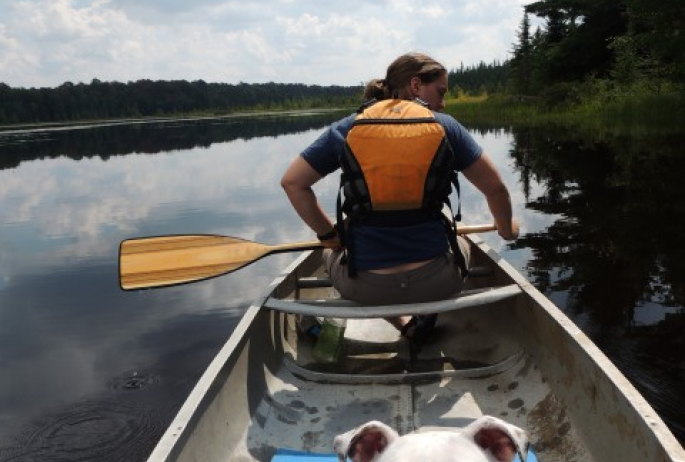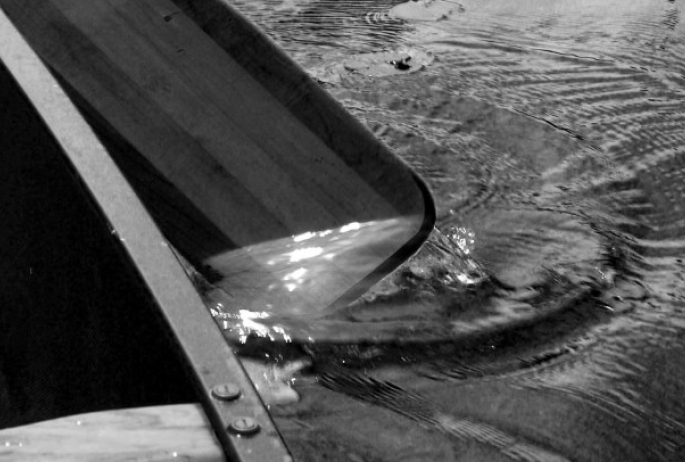When you talk about having an Adirondack adventure with your dog, most people immediately think hiking or camping. Well, I can’t argue that, it makes sense - but paddling? Not that paddling with a dog in your canoe or tandem kayak is totally out of the ordinary, but it’s much less seen than on a trail. As you may be able to imagine, the issue is keeping your dog settled in the canoe and removing that urge to make several circles before they lay down, or maybe that urge to look closely over the edge, then again maybe the urge to jump in – all of these are excellent concerns. There are a few things that you might want to look at before you start out.

Here's some things to consider:
- How large is your dog? This makes all the difference in how much a moving dog effects the functionality, stability, and safety within your boat. If you have a small dog, your concern may be more along the lines of keeping them in the boat rather than them moving around. If you have a larger dog, 30 pounds or more, slight movements might make your heart skip a beat or two. A small dog might be able to run marathons around your boat and not effect it much.
- Age of your dog is also a key factor. As you know younger dogs and pups have energy unlike older dogs that may be a bit more lethargic.
- The next thing is the overall training of your dog. Do they listen when commanded? Does your tone make them listen and respond timely? If your dog can do these things you are one step ahead of the game, if not, maybe this should be a key focus. Hiring a trainer is not out of the ordinary.
- Does your pet have a fear or anxiety around water? This can also be a set back or something that you might have to deal with early on; I did and in some ways still do on occasion.

Once you have those factors figured out there are a couple steps you can take that might help to train your dog. Along with these, TIME, plays a key factor. These things take time and lots of patience. Like me, you probably wanted your dog to go right out and be the perfect paddling companion, they’re not. Look at it from their point-of-view, a boat might be a pretty odd thing.
Doggie steps
- What I like to do is have something familiar in the boat that they recognize as their space. I used an old closed foam sleeping pad as her familiar object. This blue pad goes in the center of the boat as her spot to lie down. I use this pad during training and in the car when we are driving around, going to town, to a hike, etc… The pad also helps protect your boat and gives them something a bit more comfortable to lie and sit on.
- First, take a short trip out on a small pond, stay in the shallows, and see where you're at. Maybe you will need less training, or more, than expected. Use the pad for your pet to lie on.
- Now depending on how that went, you might need to walk the boat along shore with your pet in it, on the pad. This will create less of a chance of tipping over.
- Do some dry land training. Put your canoe up on blocks and have you dog sit in the boat on the pad without the fear of water or tipping over.
- My dog was a bit skittish of water, she’s getting over that. What you may have to do is get them wet, walk them through the water, and go swimming with them. Make them comfortable.
- Again, time, is a key factor here. Repetition is another.
Be prepared
How about doggy gear? Is there any? Should I have some? Well there isn’t too much that you need as far as special equipment is concerned. Here are a few thoughts though:
- Soft foam pad, for them to lie on to add comfort. Again used as a familiar place to be.
- Dog bowl for water, so they are not tempted to lean over the boat for a drink.
- Dog food, keep them occupied with treats when they do good, and reinforce that often.
- Life vest, for sure, they can get injured if a boat flips just as easy as you can. Most vests have loops for carry and rescue.
- Leash, to be used only when out of the boat. Don’t attach them to the boat. If the boat flips and goes downstream, so does your pet. If the boat sinks it will take your dog down with it.
- Doggy toy or bone, this could help keep them occupied and settled.
I don’t have all the answers and I welcome you to share what works for you. My dog is still a less than perfect canine paddling partner, but these are some ideas that have helped us make slow progress. She still gets very unsettled with animal sounds, length of paddle trip, and her insurmountable curiosity. I thought we were surely going to flip on our first trip out, but we didn’t; I did however develop a few more white hairs. We even tempted fate by crossing over the pond and moving away from shore, I don’t recommend that!
Our next step is to continue with the training activities above to familiarize her with a boat and its feel. Then, in the spring when the water temperatures are a bit safer, we'll go on another short paddle close to shore, on a pond that is not populated with other paddlers. Then we'll try a river with some slow current. Maybe then a short overnight excursion with a moderate distance paddle. I am not sure what the winter will hold for us; maybe she will have a season to come to terms with this new adventure, or maybe she'll forget all she's learned; only time will tell. Now, I need to teach her not to step on the back of my snowshoes.




